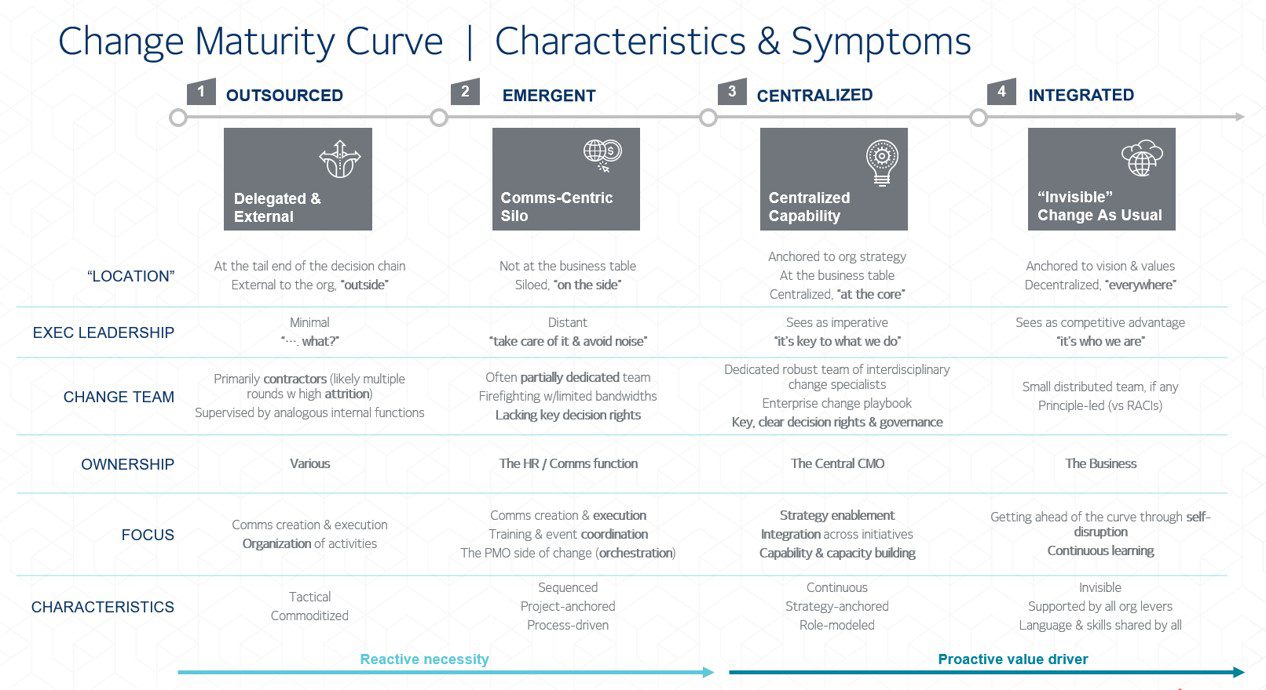The more CXOs with whom I speak, the more apparent it is: “Change as usual” is well upon us and the new “business as usual” of our times. Traditional change models of unfreeze, change and refreeze appear rather quaint against a reality of ever-present, ever-more-rapid cycles of change and transformation. Change agility and capability are no longer “nice-to-haves” but “must-haves.”
Juxtaposed against organizations’ current change capabilities, this reality can be daunting, if not downright depressing because a vast majority of companies are in the early stages of change maturity. I’m loosely defining the phases as follows:
Phase 1 | Outsourced (~30 percent of companies) – Change capability is seen as temporary and tactical; it’s deemed outsourceable and commoditized.
Phase 2 | Emergent (~55 percent of companies) – Change capability is seen primarily as a communications function with low decision-making authority and limited enterprise perspective.
Phase 3 | Centralized (~15 percent of companies) – Change is seen as strategic capability; it’s set up as a PMO/CMO governance structure working off a shared enterprise change playbook.
Phase 4 | Integrated (0 percent?) – Change is seen as integral to ways of working and core enterprise competencies; owned by and embedded across the business and thus effectively “invisible.”

If you buy into the “change as usual” narrative, you quickly realize no one is immune; organizations must evolve along the maturity curve, ensuring their change capabilities meet current, let alone future, needs… unless, that is, they can leapfrog it.
There’s a beautiful opportunity at the intersection of being a novice, yet fully grasping the need for this effort. In this case, being a committed laggard offers an interesting prospect – that of leapfrogging over the road-normally-taken and turning one’s liability into an asset.
This kind of leapfrogging is not new, and is beautifully showcased through Africa’s mobile telephony example:
The mobile revolution that swept the continent and resulted in “more Africans owning phones than having access to water or toilets,” according to Bhaskar Chakravorti, dean of global business at The Fletcher School, has been a driving force for digital transformation and investment on the continent, as well as a prime example of technological leapfrogging. It has allowed Africans to skip the landline stage of development and jump right to the digital age. – CIO Magazine
Why not do the same in terms of capability building? Unencumbered by legacy systems, roles and wounds, clear-minded and courageous organizations can choose a path different from the historical journey often taken by the competition. Leapfrogging can enable them to dramatically accelerate their time-to-impact and reap the benefits of these capabilities, while learning from those who came before them.
Here is how leapfrogging can be enabled, along with some starter questions to drive these efforts:
Ensure business ownership: Enable the business to own the development of this capability from the start, co-creating a business-led shared language around change capability and agility; integrate this language across existing rituals (strategy alignment meetings, business report outs, etc.)
- How do we talk about and enable change in a way that’s meaningful, speaks to our needs and is linked to business outcomes? (language)
- What must we do to avoid triggering our organization’s immune response and enable people to embrace growing their change muscle? (mindsets)
- How can we sustainably democratize change capability across the enterprise and embed it across our existing rituals? (rituals)
Design and adapt ecosystem: Intentionally incorporate change capability requirements into existing business systems, processes and metrics.
- What does it look like for us to operate with the agility and continuous learning orientation we seek? (systems, processes)
- What elements of our ecosystem were previously built upon assumptions of stability and must be revisited? (systems, processes)
- How will we know if we are doing this well? (metrics, leading & lagging indicators)
Embed in E2E talent lifecycle: Align the entirety of the talent value chain accordingly (recruiting, hiring, rewards, development, promotion, etc.), conducting an audit to ensure the talent “machine” is an enabler of this capability build, from mindsets to behaviors and outcomes.
- What current talent systems, processes and policies are detractors from meaningfully growing this change capability? (hard infrastructure)
- How can leaders and influencers best be enabled to role model and champion the integration and embrace of these capabilities in their normal ways of working? What supports and scaffolds do they need? (leadership enablement)
- What cultural norms must be revisited or “obstacles” must be removed to make it easier for all to enable change from any seat? (soft infrastructure)
The important attribute across these efforts is that they stop making change about change. Not unlike Fight Club, where “the first rule about Fight Club is not to talk about Fight Club,” the same could be said for change. Especially during current cognitively overloaded times, when change fatigue abounds and cynicism is on the rise, the last thing your people need is another branded campaign, yet another learning program to complete and another rally around some new initiative.
Instead, shift the change conversation and fuel your leapfrogging efforts by making them about the business and talent. The right home for the change conversation is integrated into the fabric of the organization, democratized across all employees and almost “invisible” to the naked eye.
















